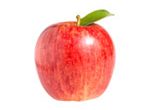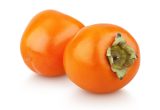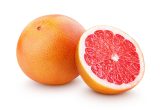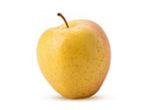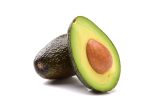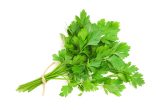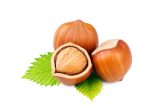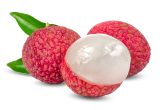Pear (Conference)

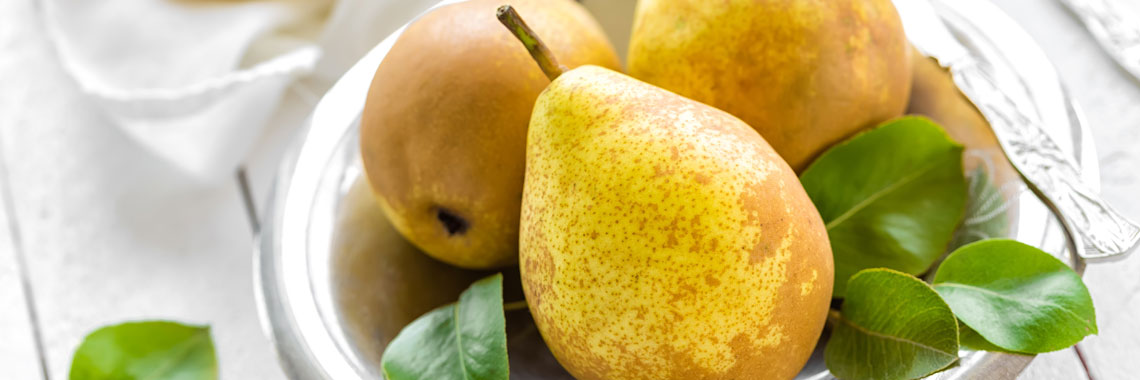
Description
- Conference pear belongs to the Rosaceae family, genus Pyrus, species communis (Chagné, 2014).
- Originally from Asia, the pear tree has been established in Europe since time immemorial. Today, more than 2,000 varieties are listed, including the Conference pear, a winter fruit born in 1885 (Centre national de pomologie d’Alès, 2010).
PHYSICAL AND ORGANOLEPTIC CHARACTERISTICS
- Pear tree flowers are white to whitish-pink with five petals and are often mistaken for apple tree flowers. In the autumn, the edible fruit, 6.5 to 10 cm long, ripen to a green to brown colour (Andreu, 2008). The pear is harvested when its skin becomes dark green to light green in colour (Nath, 2012). Like avocados or kiwis, it needs a few days after harvest to ripen (Murayama, 2006).
- Fructose is responsible for the “sweet” taste of the Conference pear, followed by sucrose and glucose. It has been shown that, compared to the core, the pulp of this type of pear is higher in fructose (Torregrosa, 2020). The impact of sugar is affected by the juiciness of the fruit: the juicier the fruit, the sweeter the taste (Visser, 1968).
- A study conducted on Japanese pears, pyrifolia species, showed that there is more titric acid but less total sugars in the core compared to the pulp. At the ripening stage, the citric acid content is 17 times higher in the core compared to the pulp (Gao, 2016).
COMPOSITION CHARACTERISTICS (excluding macronutrients, vitamins and minerals)
- Their high fibre concentration probably explains the laxative properties of pears and their effect on gut health (Reiland, 2015).
- When stored under low oxygen or carbon dioxide conditions, Conference pears may develop brown spots due to oxidation of their phenolic compounds and eventually cavities in the core of the fruit (Pedreschi, 2009).
- Numerous deposits of tannins belonging to the polyphenol family have been observed within the Conference pear. It has been found that a high content of these tannin compounds, possessing bactericidal activity, seem to improve fruit preservation (Konarska, 2013).
- Flavonoids, phenolic compounds, contribute to the colour and photoprotection of Conference pears, and may also provide defence mechanisms against microorganisms (Vrancken, 2013).
- Studies conducted using 10 pear genotypes, growing in the Ardahan region (Turkey), showed that due to the high levels of antioxidants, it is suggested to consume this fruit with its skin (Abaci, 2015).
RAW
The following values are approximate and depend on variety, season, ripeness, cultivation conditions, etc. The average Conference pear provides 53.10 calories (kcal) per 100 g, i.e. 223 kJ. A Conference pear weighs on average 120 g, representing an energy contribution of 64.92 kcal.
COMPOSITION TABLES
For each nutrient, the tables provide information on the content, minimum and maximum values, as well as the percentage of the Dietary Reference Values (DRVs) for 100 g net of raw Conference pear, without skin (except the polyphenols table which concerns unknown pear varieties, without skin).
MACRONUTRIENTS
| Constituent (g) | Average content |
Min-Max per 100g |
DRV% |
|---|---|---|---|
| Water | 85,30 | - | - |
| Fibers | 3,10 | - | - |
| Carbohydrates | 11,40 | 0 - NC | 4,38 |
| Sugars | 9,40 | - | 10,44 |
| Lipids | < 0,50 | - | - |
| Saturated fat | < 0,01 | - | - |
| Protein | < 0,50 | - | - |
| Constituent (g) | Amount | Min-Max | DRV% |
|---|---|---|---|
| Water | Ciqual 2020 (valeur issue des analyses Ciqual-Aprifel 2017) | - | - |
| Fibers | Ciqual 2020 (valeur issue des analyses Ciqual-Aprifel 2017) | - | - |
| Carbohydrates | Ciqual 2020 | - | Règlement (UE) N°1169/2011 du parlement Européen et du conseil du 25 octobre 2011 |
| Sugars | Ciqual 2020 (valeur issue des analyses Ciqual-Aprifel 2017) | - | Règlement (UE) N°1169/2011 du parlement Européen et du conseil du 25 octobre 2011 |
| Lipids | Ciqual 2020 (valeur issue des analyses Ciqual-Aprifel 2017) | - | Règlement (UE) N°1169/2011 du parlement Européen et du conseil du 25 octobre 2011 |
| Saturated fat | Ciqual 2020 (valeur issue des analyses Ciqual-Aprifel 2017) | - | Règlement (UE) N°1169/2011 du parlement Européen, et du conseil du 25 octobre 2011 |
| Protein | Ciqual 2020 (valeur issue des analyses Ciqual-Aprifel 2017) | - | Règlement (UE) N°1169/2011 du parlement Européen et du conseil du 25 octobre 2011 |
Zoom on carbohydrates
- Conference pears also contain a significant amount of carbohydrates (11.40 g per 100 g), slightly above the average for this macronutrient in fresh fruit (11.31 g per 100 g).
- These are mainly fructose (6.60 g per 100 g), sorbitol (1.80 g per 100 g), sucrose (1.60 g per 100 g) and glucose (1.20 g per 100 g).
Zoom on fibres
- The Conference pear is a source of fibre* as it provides more than 3 g of fibre per 100 g of fruit, i.e. 3.10 g per 100 g.
- This amount is higher than the average quantity found in fresh fruit (2.77 g per 100 g).
Zoom on lipids
- The Conference pear is fat-free* as it contains less than 0.5 g of fat per 100 g.
*Regulation (EC) No 1924/2006 of the European Parliament and of the Council of 20 December 2006 on nutrition and health claims made on foods.
MINERALS AND TRACE ELEMENTS
| Constituent | Average content |
Min-Max per 100g |
DRV% |
|---|---|---|---|
| Calcium (mg) | 3,90 | - | 0,49 |
| Chloride (mg) | < 20 | - | - |
| Copper (mg) | 0,05 | - | 5 |
| Iron (mg) | 0,09 | - | 0,64 |
| Iodine (µg) | < 20 | - | - |
| Magnesium (mg) | 5,30 | - | 1,41 |
| Manganese (mg) | 0,02 | - | 1 |
| Phosphorus (mg) | 9,30 | - | 1,33 |
| Potassium (mg) | 99 | - | 4,95 |
| Selenium (µg) | < 20 | - | - |
| Sodium (mg) | < 5 | - | - |
| Zinc (mg) | 0,07 | - | 0,70 |
| Constituent | Amount | Min-Max | DRV% |
|---|---|---|---|
| Calcium (mg) | Ciqual 2020 (valeur issue des analyses Ciqual-Aprifel 2017) | - | Règlement (UE) N°1169/2011 du parlement Européen et du conseil du 25 octobre 2011 |
| Chloride (mg) | Ciqual 2020 (valeur issue des analyses Ciqual-Aprifel 2017) | - | Règlement (UE) N°1169/2011 du parlement Européen et du conseil du 25 octobre 2011 |
| Copper (mg) | Ciqual 2020 (valeur issue des analyses Ciqual-Aprifel 2017) | - | Règlement (UE) N°1169/2011 du parlement Européen et du conseil du 25 octobre 2011 |
| Iron (mg) | Ciqual 2020 (valeur issue des analyses Ciqual-Aprifel 2017) | - | Règlement (UE) N°1169/2011 du parlement Européen et du conseil du 25 octobre 2011 |
| Iodine (µg) | Ciqual 2020 (valeur issue des analyses Ciqual-Aprifel 2017) | - | Règlement (UE) N°1169/2011 du parlement Européen et du conseil du 25 octobre 2011 |
| Magnesium (mg) | Ciqual 2020 (valeur issue des analyses Ciqual-Aprifel 2017) | - | Règlement (UE) N°1169/2011 du parlement Européen et du conseil du 25 octobre 2011 |
| Manganese (mg) | Ciqual 2020 (valeur issue des analyses Ciqual-Aprifel 2017) | - | Règlement (UE) N°1169/2011 du parlement Européen et du conseil du 25 octobre 2011 |
| Phosphorus (mg) | Ciqual 2020 (valeur issue des analyses Ciqual-Aprifel 2017) | - | Règlement (UE) N°1169/2011 du parlement Européen et du conseil du 25 octobre 2011 |
| Potassium (mg) | Ciqual 2020 (valeur issue des analyses Ciqual-Aprifel 2017) | - | Règlement (UE) N°1169/2011 du parlement Européen et du conseil du 25 octobre 2011 |
| Selenium (µg) | Ciqual 2020 (valeur issue des analyses Ciqual-Aprifel 2017) | - | Règlement (UE) N°1169/2011 du parlement Européen et du conseil du 25 octobre 2011 |
| Sodium (mg) | Ciqual 2020 (valeur issue des analyses Ciqual-Aprifel 2017) | - | - |
| Zinc (mg) | Ciqual 2020 (valeur issue des analyses Ciqual-Aprifel 2017) | - | Règlement (UE) N°1169/2011 du parlement Européen et du conseil du 25 octobre 2011 |
Zoom on minerals and trace elements
- The Conference pear provides:
- 5% of DRVs for copper, i.e. 0.05 mg per 100 g;
- 4.95% of DRVs for potassium, i.e. 99 mg per 100 g.
- The amount of other minerals and trace elements represents less than 2% of DRVs.
VITAMINS
| Constituent | Average content |
Min-Max per 100g |
DRV% |
|---|---|---|---|
| Provitamin A Beta-carotene (µg) | 19,30 | - | - |
| Vitamin A equivalent (µg) | 3,22 | - | 0,40 |
| Vitamin B1 (mg) | < 0,015 | - | - |
| Vitamin B2 (mg) | < 0,01 | - | - |
| Vitamin B3 (mg) | < 0,10 | - | - |
| Vitamin B5 (mg) | 0,065 | - | 1,08 |
| Vitamin B6 (mg) | < 0,01 | - | - |
| Vitamin B9 (µg) | 12,60 | - | 6,30 |
| Vitamin C (mg) | 1,39 | - | 1,74 |
| Vitamin E (mg) | < 0,08 | - | - |
| Vitamin K1 (µg) | < 0,80 | - | - |
| Constituent | Amount | Min-Max | DRV% |
|---|---|---|---|
| Provitamin A Beta-carotene (µg) | Ciqual 2020 (valeur issue des analyses Ciqual-Aprifel 2017) | - | - |
| Vitamin A equivalent (µg) | Calcul à partir de la valeur Provitamine A Béta-carotène* | - | Règlement (UE) N°1169/2011 du parlement Européen et du conseil du 25 octobre 2011 |
| Vitamin B1 (mg) | Ciqual 2020 (valeur issue des analyses Ciqual-Aprifel 2017) | - | Règlement (UE) N°1169/2011 du parlement Européen et du conseil du 25 octobre 2011 |
| Vitamin B2 (mg) | Ciqual 2020 (valeur issue des analyses Ciqual-Aprifel 2017) | - | Règlement (UE) N°1169/2011 du parlement Européen et du conseil du 25 octobre 2011 |
| Vitamin B3 (mg) | Ciqual 2020 (valeur issue des analyses Ciqual-Aprifel 2017) | - | Règlement (UE) N°1169/2011 du parlement Européen et du conseil du 25 octobre 2011 |
| Vitamin B5 (mg) | Ciqual 2020 (valeur issue des analyses Ciqual-Aprifel 2017) | - | Règlement (UE) N°1169/2011 du parlement Européen et du conseil du 25 octobre 2011 |
| Vitamin B6 (mg) | Ciqual 2020 (valeur issue des analyses Ciqual-Aprifel 2017) | - | Règlement (UE) N°1169/2011 du parlement Européen et du conseil du 25 octobre 2011 |
| Vitamin B9 (µg) | Ciqual 2020 (valeur issue des analyses Ciqual-Aprifel 2017) | - | Règlement (UE) N°1169/2011 du parlement Européen et du conseil du 25 octobre 2011 |
| Vitamin C (mg) | Ciqual 2020 (valeur issue des analyses Ciqual-Aprifel 2017) | - | Règlement (UE) N°1169/2011 du parlement Européen et du conseil du 25 octobre 2011 |
| Vitamin E (mg) | Ciqual 2020 | - | Règlement (UE) N°1169/2011 du parlement Européen et du conseil du 25 octobre 2011 |
| Vitamin K1 (µg) | Ciqual 2020 (valeur issue des analyses Ciqual-Aprifel 2017) | - | Règlement (UE) N°1169/2011 du parlement Européen et du conseil du 25 octobre 2011 |
Zoom on vitamins
- The Conference pear provides a significant amount of vitamin B9. In fact, it contains the equivalent of 6.30% of DRVs, i.e. 12.60 µg per 100 g.
- The quantity of other vitamins represents less than 2% of DRVs.
*Calculation made: Beta Carotene / 6 + retinol
POLYPHENOLS
| Constituent (mg) | Average content |
Min-Max per 100mg |
|---|---|---|
| Flavonoids (mg) | 3,42 | 1,27 - 7,28 |
| of which Flavanols (mg) | 3,42 | 1,27 - 7,28 |
| Phenolic Acids (mg) | 3,50 | 1,17 - 5,50 |
| of which Hydroxycinnamic acids (mg) | 3,50 | 1,17 - 5,50 |
| Other Polyphenols (mg) | 1,40 | 0 - 1,92 |
| Total polyphenols | 8,32 | 2,44 - 14,70 |
| Constituent (mg) | Amount | Min-Max |
|---|---|---|
| Flavonoids | Phénol-Explorer version 3.6 Méthode utilisée : chromatographie | - |
| of which Flavanols | Phénol-Explorer version 3.6 Méthode utilisée : chromatographie | - |
| Phenolic Acids | Phénol-Explorer version 3.6 Méthode utilisée : chromatographie | - |
| of which Hydroxycinnamic acids | Phénol-Explorer version 3.6 Méthode utilisée : chromatographie | - |
| Other Polyphenols | Phénol-Explorer version 3.6 Méthode utilisée : chromatographie | - |
| Total polyphenols | Phénol-Explorer version 3.6 Méthode utilisée : chromatographie | - |
Zoom on polyphenols (unknown varieties of pears analysed, without skin)
- Polyphenols are substances with an antioxidant effect.
- Hydroxycinnamic acids, which are part of the phenolic acids, are predominantly present in pear composites, representing 42.07% of the total polyphenols identified.
- Next come flavanols, which are part of the flavonoids (41.11% of total polyphenols).
Nutrition and health claims
According to the definitions of nutrition claims as set out in Regulation (EC) No 1924/2006 on nutrition and health claims, and in view of the composition of the Conference pear, the following nutrition claims may be used:
NUTRITION CLAIMS OF CONFERENCE PEARS (raw, without skin)
- Fat-free (100 g of Conference pears contain less than 0.5 g of fat)
- Source of fibre (100 g of pears provide more than 3 g of fibre)
References
- Abaci ZT, Sevindik E, Ayvaz M. Comparative study of bioactive components inpear genotypes from Ardahan/Turkey. Biotechnology &Biotechnological Equipment. 2015. 30(1): 36-43
- Agence nationale de sécurité sanitaire de l’alimentation, de l’environnement et du travail. Table de composition nutritionnelle des aliments Ciqual 2020. Consultée le 17/08/2020 depuis le site internet Ciqual https://ciqual.anses.fr/
- Andreu MG, Friedman MH, Northrop RJ. 2008. Pyruscommunis, common pear [en ligne]. [consulté le 19/02/2020]. Disponible à l’adresse : https://www.growables.org/information/LowChillFruit/documents/PyrusCommunisCommonPear.pdf.
- Centre National de Pomologie d’Ales, Ministère de l’Agriculture. 2010. fiche_poire.pdf [en ligne]. [consulté le 19/02/2020]. Réalisé pour la direction générale de l’alimentation dans le cadre d’un fruit à la récréation. Disponible à l’adresse : https://agriculture.gouv.fr/sites/minagri/files/documents/pdf/fche_poire.pdf.
- Chagné D, Crowhurst RN, Pindo M. The draft genome sequence of European pear (Pyrus communis L. ‘Bartlett’). PLoS One. 2014;9(4):e92644.
- Gao Z, Zhang C, Luo M, Wu Y, Duan S, Li J, Wang L, Song S, Xu W, Wang S, Zhang C, Ma C. Proteomic analysis of pear (Pyrus pyrifolia) ripening process provides new evidence for the sugar/acid metabolism difference between core and mesocarp. Proteomics. 2016 Dec;16(23):3025-41.
- Konarska A. The Relationship between the Morphology and Structure and the Quality of Fruits of Two Pear Cultivars (Pyrus communis L.) during Their Development and Maturation. The Scientific World Journal. 2013;2013(1):1-13.
- Murayama H, Sekine D, Yamauchi Y, Gao M, Mitsuhashi W, Toyomasu T. Effect of Girdling above the Abscission Zone of Fruit on “Bartlett” Pear Ripening on the Tree. Journal of Experimental Botany. 2006;57(14):3679‑86.
- Nath A, Deka BC, Singh A, Patel RK, Paul D, Misra LK, Ojha H. Extension of shelf life of pear fruits using different packaging materials. J Food Sci Technol. 2012 Oct;49(5):556-63.
- Neveu V, Perez-Jiménez J, Vos F, Crespy V, du Chaffaut L, Mennen L, Knox C, Eisner R, Cruz J, Wishart D, Scalbert A. (2010) Phenol-Explorer: an online comprehensive database on polyphenol contents in foods. Database, doi: 10.1093/database/bap024. Full text (free access)
- Pedreschi R, Franck C, Lammertyn J, Erban A, Kopka J, Hertog M, Verlinden B, Nicolaï B. Metabolic profiling of ‘Conference’ pears under low oxygen stress. Postharvest Biology and Technology. 2009;51(2):123-30.
- Reiland H, Slavin J. Systematic Review of Pears and Health. Nutr Today. 2015;50(6):301–05.
- Règlement (CE) N° 1924/2006 du Parlement européen et du Conseil du 20 décembre 2006 concernant les allégations nutritionnelles et de santé portant sur les denrées alimentaires.
- Règlement (UE) N°432/2012 de la Commission du 16 mai 2012 établissant une liste des allégations de santé autorisées portant sur les denrées alimentaires, autres que celles faisant référence à la réduction du risque de maladie ainsi qu’au développement et à la santé infantiles.
- Règlement (UE) n°1169/2011 du Parlement européen et du Conseil du 25 octobre 2011 concernant l’information des consommateurs sur les denrées alimentaires, modifiant les règlements (CE) n°1924/2006 et (CE) n°1925/2006 du Parlement européen et de Conseil et abrogeant la directive 87/250/CEE de la Commission, la directive 90/496/CEE du Conseil, la directive 1999/10/CE de la Commission, la directive 200/13/CE du Parlement européen et du Conseil, les directives 2002/67/CE et 2008/5/CE de la Commission et le règlement (CE) n°608/2004 de la Commission.
- Torregrosa L, Echeverria G, Illa J, Torres R, Giné-Bordonaba J. Spatial distribution of flavor components and antioxidants in the flesh of ‘Conference’ pears and its relationship with postharvest pathogens susceptibility. Postharvest Biology and Technology. 2020;159(1):111004
- Tuğba Abacı Z, Sevindik E, Ayvaz M. Comparative study of bioactive components in pear genotypes from Ardahan/Turkey. Biotechnology & Biotechnological Equipment. 2016;30(1):36-43.
- Visser T, Schaap AA, De Vries DP. Acidity and sweetness in apple and pear. Euphytica. 1968;17(1):153-67.
- Vrancken K, Holtappels M, Schoofs H, Deckers T, Treutter D, Valcke R. Erwinia amylovora affects the phenylpropanoid-flavonoid pathway in mature leaves of Pyrus Communis cv. Conférence. Plant Physiology and Biochemistry. 2013;72(1):134‑44.





